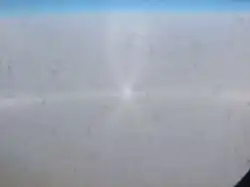
This photo centred at the antisolar point shows various antisolar halos, as seen on a flight from Brussels to Madrid on 7 August 2006.
(Credit: Francesco De Comité)
(Credit: Francesco De Comité)
The subparhelic circle is a rare halo, an optical phenomenon, located below the horizon. It passes through both the subsun (below the Sun) and the antisolar point (opposite to the Sun). The subparhelic circle is the subhorizon counterpart to the parhelic circle, located above the horizon.
Located on the subparhelic circle are several relatively rare optical phenomena: the subsun, the subparhelia, the 120° subparhelia, Liljequist subparhelia, the diffuse arcs, and the Parry antisolar arcs.[1][2]
On the accompanying photo centred at the antisolar point, the subparhelic circle appears as a gently curved horizontal line intercepted by anthelic arcs.[3]
See also
References
- ↑ Cowley, Les. "Subhorizon Arcs". Atmospheric Optics. Retrieved 2007-04-21. (including a computer simulation)
- ↑ Cowley, Les. "Antisolar Region Arcs". Atmospheric Optics. Retrieved 2007-04-21. (including a photo and a computer simulation)
- ↑ Moilanen, Jarmo. "Subhorizon diffuse arcs with Liljequist subparhelia". Halo Reports (Blogspot). Retrieved 2007-04-21.
External links
This article is issued from Wikipedia. The text is licensed under Creative Commons - Attribution - Sharealike. Additional terms may apply for the media files.